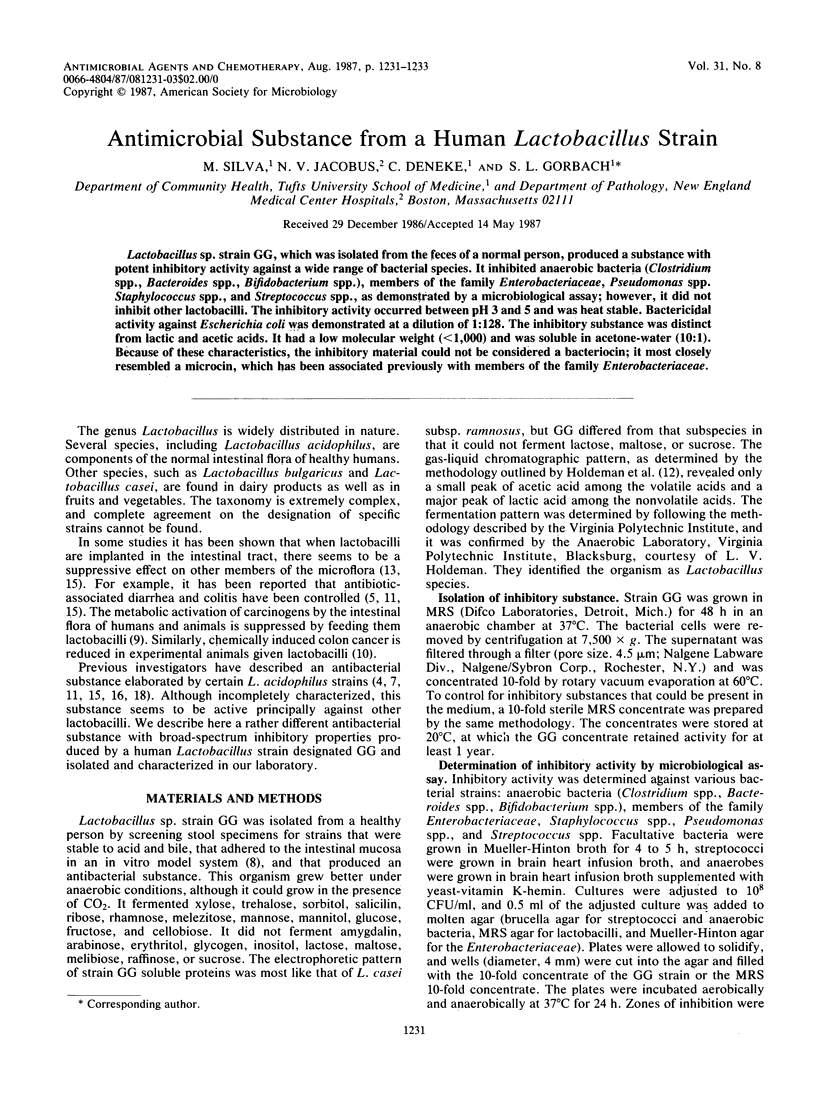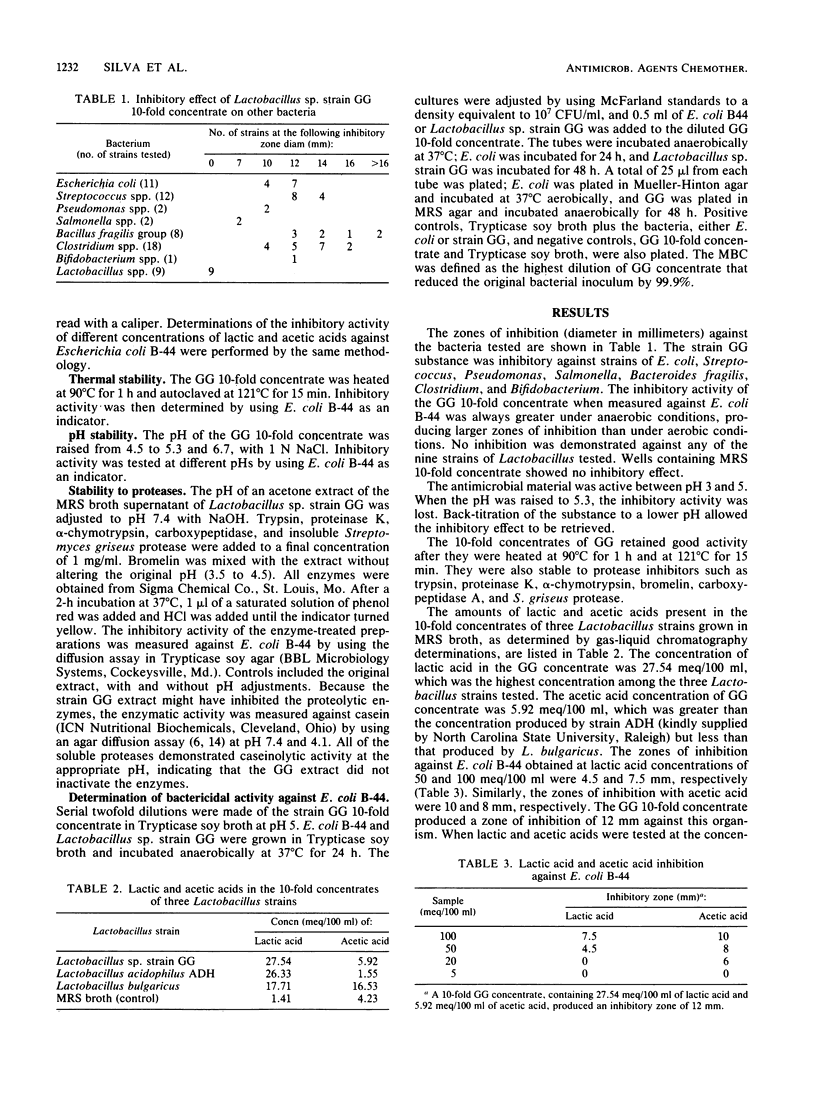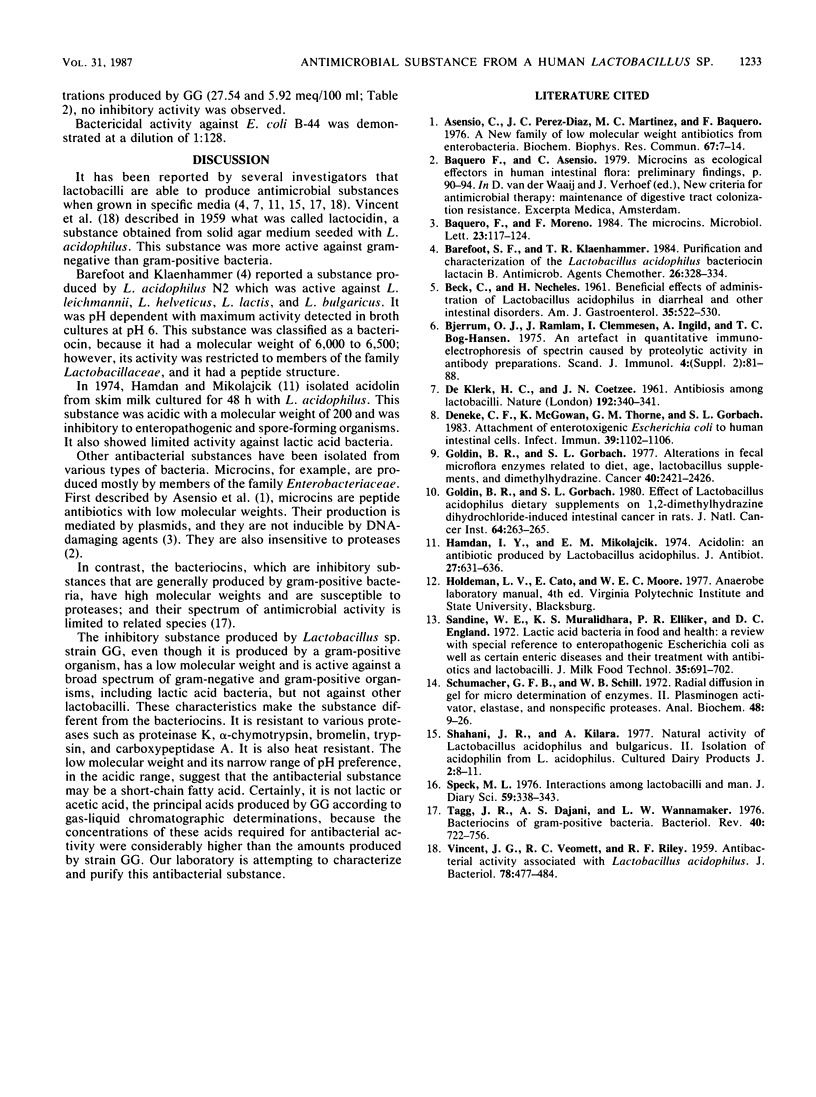Abstract
Lactobacillus sp. strain GG, which was isolated from the feces of a normal person, produced a substance with potent inhibitory activity against a wide range of bacterial species. It inhibited anaerobic bacteria (Clostridium spp., Bacteroides spp., Bifidobacterium spp.), members of the family Enterobacteriaceae, Pseudomonas spp. Staphylococcus spp., and Streptococcus spp., as demonstrated by a microbiological assay; however, it did not inhibit other lactobacilli. The inhibitory activity occurred between pH 3 and 5 and was heat stable. Bactericidal activity against Escherichia coli was demonstrated at a dilution of 1:128. The inhibitory substance was distinct from lactic and acetic acids. It had a low molecular weight (less than 1,000) and was soluble in acetone-water (10:1). Because of these characteristics, the inhibitory material could not be considered a bacteriocin; it most closely resembled a microcin, which has been associated previously with members of the family Enterobacteriaceae.
Full text
PDF


Selected References
These references are in PubMed. This may not be the complete list of references from this article.
- Asensio C., Pérez-Díaz J. C. A new family of low molecular weight antibiotics from enterobacteria. Biochem Biophys Res Commun. 1976 Mar 8;69(1):7–14. doi: 10.1016/s0006-291x(76)80264-1. [DOI] [PubMed] [Google Scholar]
- BECK C., NECHELES H. Beneficial effects of administration of Lactobacillus acidophilus in diarrheal and other intestinal disorders. Am J Gastroenterol. 1961 May;35:522–530. [PubMed] [Google Scholar]
- Barefoot S. F., Klaenhammer T. R. Purification and characterization of the Lactobacillus acidophilus bacteriocin lactacin B. Antimicrob Agents Chemother. 1984 Sep;26(3):328–334. doi: 10.1128/aac.26.3.328. [DOI] [PMC free article] [PubMed] [Google Scholar]
- DE KLERK H. C., COETZEE J. N. Antibiosis among lactobacilli. Nature. 1961 Oct 28;192:340–341. doi: 10.1038/192340a0. [DOI] [PubMed] [Google Scholar]
- Deneke C. F., McGowan K., Thorne G. M., Gorbach S. L. Attachment of enterotoxigenic Escherichia coli to human intestinal cells. Infect Immun. 1983 Mar;39(3):1102–1106. doi: 10.1128/iai.39.3.1102-1106.1983. [DOI] [PMC free article] [PubMed] [Google Scholar]
- Goldin B. R., Gorbach S. L. Effect of Lactobacillus acidophilus dietary supplements on 1,2-dimethylhydrazine dihydrochloride-induced intestinal cancer in rats. J Natl Cancer Inst. 1980 Feb;64(2):263–265. doi: 10.1093/jnci/64.2.263. [DOI] [PubMed] [Google Scholar]
- Goldin B., Gorbach S. L. Alterations in fecal microflora enzymes related to diet, age, lactobacillus supplements, and dimethylhydrazine. Cancer. 1977 Nov;40(5 Suppl):2421–2426. doi: 10.1002/1097-0142(197711)40:5+<2421::aid-cncr2820400905>3.0.co;2-i. [DOI] [PubMed] [Google Scholar]
- Hamdan I. Y., Mikolajcik E. M. Acidolin: an antibiotic produced by Lactobacillus acidophilus. J Antibiot (Tokyo) 1974 Aug;27(8):631–636. doi: 10.7164/antibiotics.27.631. [DOI] [PubMed] [Google Scholar]
- Schumacher G. F., Schill W. B. Radial diffusion in gel for micro determination of enzymes. II. Plasminogen activator, elastase, and nonspecific proteases. Anal Biochem. 1972 Jul;48(1):9–26. doi: 10.1016/0003-2697(72)90165-0. [DOI] [PubMed] [Google Scholar]
- Speck M. L. Interactions among lactobacilli and man. J Dairy Sci. 1976 Feb;59(2):338–343. doi: 10.3168/jds.S0022-0302(76)84207-5. [DOI] [PubMed] [Google Scholar]
- Tagg J. R., Dajani A. S., Wannamaker L. W. Bacteriocins of gram-positive bacteria. Bacteriol Rev. 1976 Sep;40(3):722–756. doi: 10.1128/br.40.3.722-756.1976. [DOI] [PMC free article] [PubMed] [Google Scholar]
- VINCENT J. G., VEOMETT R. C., RILEY R. F. Antibacterial activity associated with Lactobacillus acidophilus. J Bacteriol. 1959 Oct;78:477–484. doi: 10.1128/jb.78.4.477-484.1959. [DOI] [PMC free article] [PubMed] [Google Scholar]


